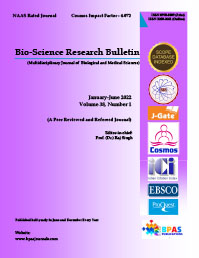A Study on the Allelopathic Impact of Chenopodium murale L. on Wheat Crop Plants
DOI:
https://doi.org/10.48165/Keywords:
Allelopathy, Allelochemicals, Chenopodium, Wheat, Inhibitory effectAbstract
Allelopathy is a mutual biological occurrence in which the growth, development, and reproduction of other organisms are impacted by the biochemicals produced by one organism. Allelochemicals are a class of biochemicals that can either benefit or harm the target species. Plant allelopathy is one of the ways that receptor and donor plants interact, and it can have either beneficial or negative effects. Organic soluble plant extracts have an inhibitory impact. A dose–response relationship analysis is required in bioassay laboratory tests, since the stronger inhibitory impact of higher concentration extracts may be attributed not only to allelopathy but also to enhanced osmotic potential. The negative effect on seedling growth is often larger in bioassays than the influence on germination rate. To study the effect of Chenopodium on wheat crop was studied by applying leaf extract of Chenopodium murale on wheat plant. The weed samples of C. murale were collected from fields and road sides of the University. The different concentration of Chenopodium extract (i.e. 50%, 75%, 100%) were appliedon wheat plants. The results after three days were compared with the control. The result shows that Chenopodium has less inhibitory effect at lower concentration and strong inhibitory effect at higher concentration.
References
Rajcan, I., and Swanton, C. J. (2001). Understanding maize–weed competition: resource competition, light quality and the whole plant. Field crops research, 71(2), 139- 150.
Jabran, K., Mahajan, G., Sardana, V., and Chauhan, B. S. (2015). Allelopathy for weed control in agricultural systems. Crop protection, 72, 57-65.
Dmitrović, S., Simonović, A., Mitić, N., Savić, J., Cingel, A., Filipović, B., and Ninković, S. (2015). Hairy root exudates of allelopathic weed Chenopodium murale L. induce oxidative stress and down-regulate core cell cycle genes in Arabidopsis and wheat seedlings. Plant growth regulation, 75(1), 365-382.
Duke, S.O., Dayan, F.F., Rimando, A.M. (1998). Natural products as tools for weed management. Proc. Japan Weed Sci. Suppl, 1-11.
Rice, E.L. (1984). Allelopathy, 2nd ed. New York: Academic Press.
Dekker, J. and Meggitt, W.F. (1983) Interference between velvetleaf (Abutilon theophrasti Medic.) and soybean (Glycine max L. Merr.). I. Growth. Weed Res.23, 91– 101.
Putnam, A.R. (1988). Weed Tech. 2, 510-518. 8. Anonymous (2017) Invasive species compendium database, CAB International. 9. Daizy, R., P.S. Harminder, R. Nipunika and K.K. Ravinder. (2006). Assessment of allelopathic interference of Chenopodium album through its leachates, debris extracts rhizophere and amended soil. Arch. Agron. Soil Sci., 52, 705-715.
Mallik, M.A.B., R. Puchala and F.A. Grosz. (1994). A growth inhibitory factor from lambsquarters (Chenopodium album). J. Chem. Ecol., 20(4), 957-967.
Roy, B., M.R. Alam, B.C. Sarker, M.S. Rahman, M.J. Islam, M.A. Hakim and R.I. Mahmood. (2006). Effect of aqueous extracts of some weeds on germination and growth of wheat and jute seeds with emphasis on chemical investigation. J. Biol. Sci., 6(2), 412- 416.
Rezaie, FM. Yarnia. (2009). Allelopathic effects of Chenopodium album, Amaranthus
retroflexus and Cynodon dactylon on germination and growth of safflower. J. Food Agric. Env., 7(2), 516-521.
Holm, L., Doll, J., Holm, E., Pancho, J. and Herberger, J. (1997). World weeds natural histories and distribution. John Willey & Sons, Inc. New York, 1129pp.
Mitic, N., Dmitrovic, S., Zdravkovic-Korac, S., Nikolic, R., Raspor M, Djordjevic V, Zivkovic, S, Krstic-Milosevic, D., Stanisic, M., andNinkovic, S. (2012). Use of Chenopodiuum murale L. transgenic hairy root in vitro culture system as a new tool for allelopathic assays. J Plant Physiol, 160, 1203–1211.
El-Khatib, A.A and Abd-Ellah, G.A. (1998). Allelopathic potential of Zillaspinosa on growth of associate flowering plants and some rhizosphere fungi Biol, Plantarium, 41, 461-467.
Cutillo, F., B.D. Abrosca, M.D. Greca, C.D. Marino, A. Golino, L. Previtera and A. Zarrelli. (2003). Cinnamic acid amides from Chenopodium album: effects on seeds germination and plant growth. Phytochemistry, 64 (8), 1381-1387.
Einhellig, F. A. (1995). Allelopathy: current status and future goals.10.1021/bk-1995- 0582.ch001
Singh, R., Upadhyay, S.K., Singh,B.J., Verma, R., Sharma, I., Sharma, P., Rani A. and Singh, C. (2021). Allelopathic Effect Of Eucalyptus (Eucalyptus camaldulensis Dehnh) on the Growth of Aloe vera. Plant Cell Biotechnology and Molecular Biology, 22(21&22), 94-100.
Singh, R., Upadhyay, S.K., Rani A. Kumar, P., Sharma, P., Sharma, I., Singh, C., Chauhan N and Kumar M. (2020). Ethnobotanical Study of Weed Flora at District Ambala, Haryana, India: Comprehensive Medicinal and Pharmacological Aspects of Plant Resources. International Journal of Pharmaceutical Research, Jan.-June 12(Spl.) 1, 1941-1956.
